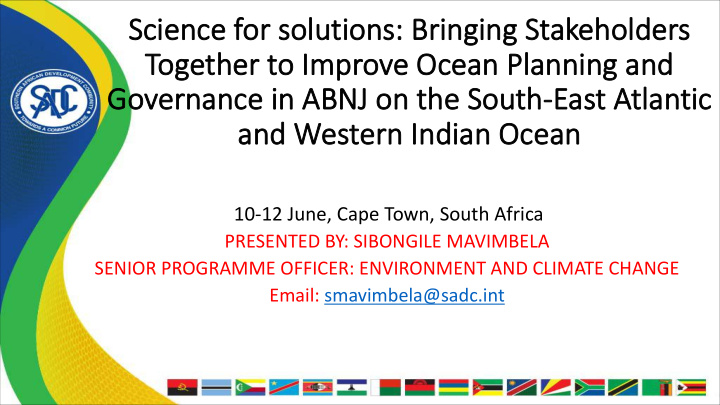



Science for solutions: Bringing Stakeholders Together to Improve Ocean Planning and Governance in ABNJ on the South-East Atlantic and Western Indian Ocean 10-12 June, Cape Town, South Africa PRESENTED BY: SIBONGILE MAVIMBELA SENIOR PROGRAMME OFFICER: ENVIRONMENT AND CLIMATE CHANGE Email: smavimbela@sadc.int 1
SADC Member States • 2
3
4
SADC Protocols and Strategies on Ocean Governance • Dedicated Blue Economy Strategy • Development of a Blue Economy Strategy is currently underway • Overarching Frameworks • SADC Industrialisation Strategy and Roadmap (2015) and related Action Plan (2017) • SADC Regional Indicative Strategic Development Plan 2005-2015 (RISDP) (adopted in 2003) • Revised RISDP 2015-2020 (adopted in 2015) • Regional Agricultural Policy (RAP: adopted in 2014)
SADC Protocols and Strategies on Ocean Governance • Thematic / Sectoral protocols and strategies • Protocol on Environmental Management for Sustainable Development (2014) • SADC Climate Change Strategy and Action Plan (2014) • Green Economy Strategy and Action Plan for Sustainable Development (2015)
SADC Protocols and Strategies on Ocean Governance (cont.) • Thematic / Sectoral protocols and strategies • Protocol on Fisheries (2001) • Statement of Commitment by SADC Ministers Responsible for Marine Fisheries on Illegal, Unreported and Unregulated Fishing (2008) • Regional Plan of Action for IUU (2008) • Regional Aquaculture Strategy and Action Plan 2016-2026 (2016) • IUU Task Force • Regional Monitoring, Control and Surveillance Coordination Centre • Collaborations (FAO, WWF, Stop Illegal Fishing and other partners)
Programmatic interventions related to coastal and marine resource management • SADC processes to support implementation of frameworks and protocols (Summit, Council of Ministers, sectoral Ministerial meetings • Tripartite Free Trade Area (SADC-COMESA-EAC) • Regional Value Chains • Task teams (e.g. natural gas, transfrontier conservation, fourth industrial revolution, Blue Economy)
Opportunities • Strategic geographical position of SADC • Alignment of key strategies, frameworks and protocols with the objectives of the Nairobi Convention and major projects (WIOSAP, SAPPHIRE) (yet to align with AC, BCC, RECs) • Political will • MOU with UN Environment (incl. NC & AC)
Challenges • Capacity (financial and technical) • Research and knowledge gaps • ‘Domestication’ of policies, protocols and action plans • Monitoring to support implementation of action plans and other commitments
Future Direction • Strengthen collaboration and joint implementation of programmes/initiatives (between MS, RECs, Regional Seas Programmes, Research partners, etc) • Strengthen knowledge sharing platforms • Exploit synergies in work programmes • Using Science to inform policy and decision- making
SADC’s view on Governance in ABNJ The United Nations Convention on the Law of the Sea sets out a framework of maritime zones with associated rights and responsibilities, the key distinction being between the Exclusive Economic Zone, within which states have a right to exploit living and non-living natural resources, and areas beyond national jurisdiction (ABNJ), where a distinction is made between the seafloor and subsoil resources (‘the Area’) and the water column (the high seas).
SADC’s view on Governance in ABNJ It is important that SADC Member States remain engaged with this developing governance regime as it presents opportunities for both conflict and cooperation related, for example, to extended continental shelf claims, maritime boundary disputes and inputs on global negotiations relating to seabed mining (though the I n t e r n a t i o n a l S e a b e d A u t h o r i t y ) a n d t h e Intergovernmental Conference on an international legally binding instrument on the conservation and sustainable use of marine biological diversity of areas beyond national jurisdiction.
SADC’s view on Governance in ABNJ • We support the management of large marine areas and ecosystems (i.e. Benguela Current Commission), Regional Seas Programmes (Nairobi Convention & Abidjan Convention). • We support integrated coastal zone governance and marine spatial planning (e.g. MSP Act 2018 for RSA). • We support the adoption of these governance tools and believe beyond the EEZ, they are relevant in improving ocean planning and governance in ABNJ of the South- East Atlantic and Western Indian Ocean.
THANK YOU! Merci! Obrigado!
Recommend
More recommend